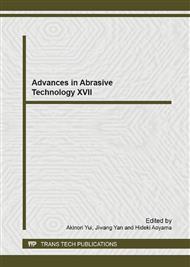p.565
p.573
p.580
p.586
p.592
p.598
p.604
p.610
p.619
Computer-Aided Simulation of Dressing Using Diamond Rotary Dresser and Visualization of Dressing Process
Abstract:
The surface of a grinding wheel dressed by a diamond rotary dresser was generated by computer-aided simulation for the case of multipass dressing on the assumption that the grinding wheel is a homogeneous solid body and the dressing trajectories of the diamond grits are perfectly copied on the grinding wheel surface. The dressing process was visualized as a contour map of the dressed surface profile and the effects of the dressing strategy, i.e., down-cut dressing or up-cut dressing, on the grinding wheel removal process were investigated. It was found that the diamond grits remain the residual depth of cut on the surface of the grinding wheel, resulting in an actual depth of cut larger than that given by the rotary dresser.
Info:
Periodical:
Pages:
592-597
Citation:
Online since:
September 2014
Authors:
Price:
Сopyright:
© 2014 Trans Tech Publications Ltd. All Rights Reserved
Share:
Citation:


